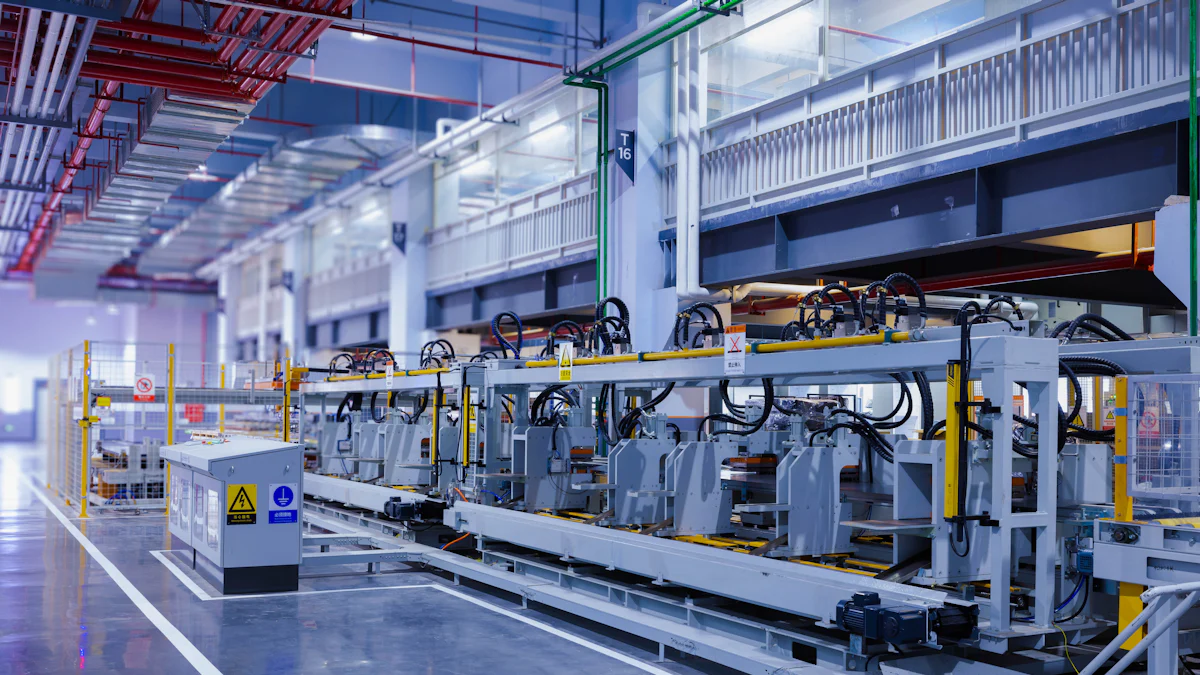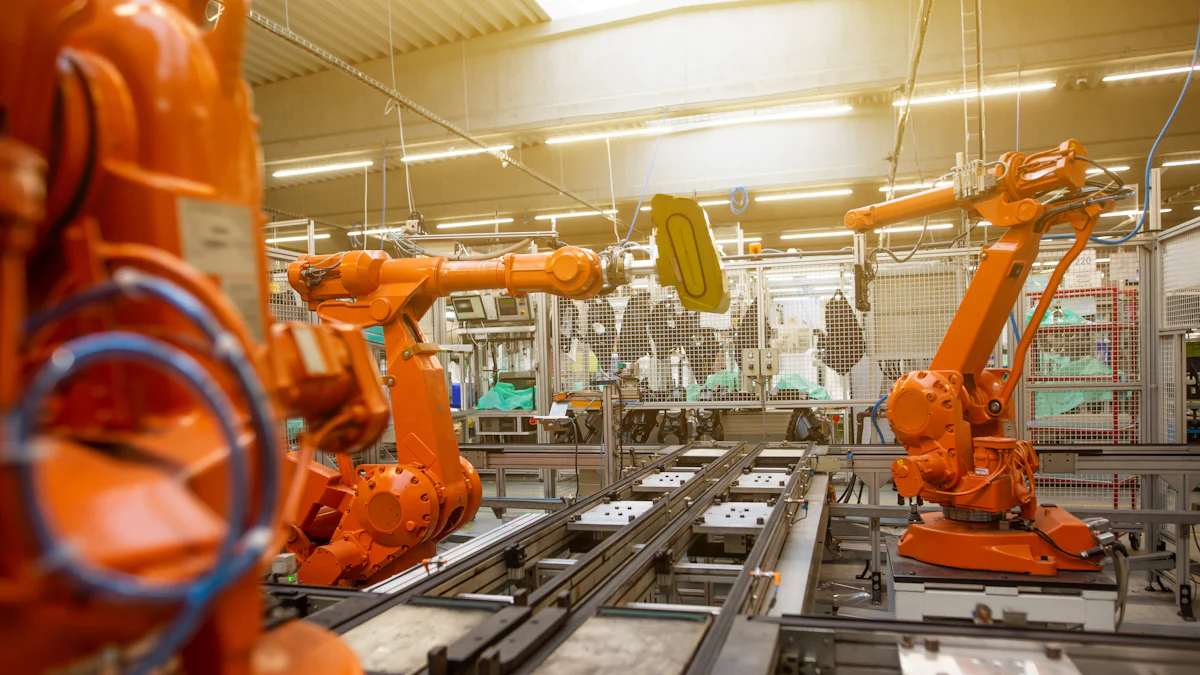Emerging Trends in the Manufacturing Industry Supply Chain for 2025

The manufacturing industry is undergoing a significant transformation driven by rapid advancements in technology and shifting global dynamics. Supply chain management has become a critical focus area as businesses face increasing pressures to adapt to evolving challenges. Recent data highlights the urgency of this shift. For instance, 84.6% of companies report higher operational costs due to disruptions, while 70% have experienced financial damage from cybercrime. These figures underscore the need for innovation and resilience in navigating anticipated trends. As digital transformation accelerates, businesses must embrace change to remain competitive in a landscape shaped by emerging trends for 2025.
Challenges Impacting the Manufacturing Industry Supply Chain
Labor Shortages in Manufacturing
Aging workforce and skills gap
The manufacturing industry faces a growing challenge due to an aging workforce. Nearly one-quarter of the workforce was aged 55 or older as of 2017, and this trend continues to rise. By 2050, 30% of the global workforce will be over 50, creating a significant skills gap. Many manufacturers express concern about brain drain, with 97% acknowledging the issue and almost half being very concerned. While older workers bring valuable experience, their retirement leaves a void in technical expertise. This gap is further widened by the demand for tech-related skills, with 10 million manufacturing jobs remaining vacant globally.
Demand for advanced manufacturing expertise
Modern manufacturing requires expertise in advanced technologies like robotics and automation. However, negative perceptions of the industry deter younger generations from pursuing careers in this field. Only 40% of parents encourage their children to consider manufacturing jobs. Additionally, job security concerns and low wages contribute to labor shortages. For instance, 63% of workers avoid jobs lacking security, while 62% prioritize salaries when considering employment. Addressing these issues is critical to attracting skilled talent.
Geopolitical and Economic Tensions
Trade restrictions and their effects on supply chain management
Geopolitical tensions have disrupted supply chain management globally. The US-China trade war, for example, led to increased tariffs, forcing manufacturers to shift production to other countries or explore domestic options. Similarly, the Ukrainian-Russian conflict resulted in trade embargoes, limiting sourcing capabilities for western companies. While trade liberalization agreements like NAFTA have reduced tariffs for some industries, others face challenges from heightened competition. These dynamics compel manufacturers to diversify their sourcing strategies, which can be both complex and costly.
Regionalization and its impact on sourcing strategies
Regionalization has emerged as a response to geopolitical uncertainties. Companies increasingly seek local suppliers to reduce reliance on global networks. For instance, power usage restrictions in certain regions have caused factory suspensions, prompting businesses to find alternative suppliers. Rising raw material costs and reduced hydropower production further highlight the need for regional sourcing. Although regionalization enhances resilience, it requires careful planning to balance costs and efficiency.
Cybersecurity Threats in Supply Chain Management
Risks to digital infrastructure and data security
The manufacturing sector faces significant cybersecurity threats due to its reliance on interconnected systems. Supply chain attacks exploit vulnerabilities in third-party vendors, with 20% of attacks originating from supplier weaknesses. Attackers may compromise software updates or inject malicious code into vendor systems, spreading to manufacturers. Insider threats also pose risks, as employees or contractors may unintentionally or intentionally compromise data. Additionally, nation-state actors target proprietary designs and technologies through phishing and unpatched vulnerabilities.
Strategies for mitigating cyber risks
Manufacturers must adopt proactive measures to safeguard their supply chains. Segmenting IT and operational technology systems can prevent ransomware from spreading. Regularly updating legacy systems and patching vulnerabilities reduces the risk of sabotage. Building robust cybersecurity frameworks and training employees to recognize threats are essential steps. By prioritizing digital security, manufacturers can protect their operations and maintain resilience.
Supply Chain Disruptions and Delays
Lessons from recent global crises
Global crises have exposed vulnerabilities in supply chains, forcing manufacturers to rethink their strategies. The COVID-19 pandemic disrupted production and logistics worldwide, creating shortages of raw materials and finished goods. Lockdowns and travel restrictions caused delays in shipping, leaving businesses unable to meet customer demands. For example, semiconductor shortages during the pandemic halted production in industries like automotive and electronics. These events highlighted the importance of diversifying suppliers and building more resilient supply chains.
The Suez Canal blockage in 2021 further demonstrated the fragility of global trade routes. A single incident delayed the movement of goods worth billions of dollars, affecting industries across the globe. Manufacturers learned that over-reliance on specific shipping lanes or suppliers increases risks. By adopting agile supply chain models, businesses can respond more effectively to unexpected challenges.
Climate-related challenges and natural disasters
Climate-related events have become a significant source of supply chain disruption. In the past year, 26.6% of organizations reported adverse effects from extreme weather and natural disasters. These events caused productivity losses for nearly 80% of businesses and service interruptions for 75.4% of respondents.
Recent examples illustrate the scale of these challenges. Severe flooding and landslides in Spain during late October damaged critical infrastructure, including highways and railways. This disruption impacted major warehouse and distribution centers, particularly in the automotive and manufacturing sectors. Events like these underscore the need for manufacturers to invest in climate-resilient infrastructure and diversify their logistics networks.
Proactive measures, such as using predictive analytics to anticipate weather-related risks, can help mitigate these challenges. Additionally, manufacturers can collaborate with local suppliers to reduce the impact of regional disasters. By prioritizing adaptability, businesses can maintain continuity in the face of climate-related disruptions.
Emerging Trends in Supply Chain Management for 2025

Automation and Artificial Intelligence in Manufacturing
Robotics for production efficiency
Automation is transforming the manufacturing industry by improving efficiency and reducing human error. Companies like Amazon and Walmart have adopted robots for tasks such as picking and packing, which enhances speed and accuracy. Fully automated warehouses now use robotic systems to perform precision tasks, streamlining operations. Collaborative robots, or cobots, work alongside humans to improve safety and productivity in manufacturing operations. These advancements in technology allow manufacturers to meet growing demands while maintaining high-quality control standards.
Predictive analytics for supply chain optimization
Artificial intelligence plays a critical role in optimizing supply chain operations. Predictive analytics enables businesses to forecast demand and adjust inventory levels accordingly. AI algorithms analyze real-time data to anticipate disruptions, allowing manufacturers to take proactive measures. For example, predictive models recommend optimal stock levels, reducing the risk of shortages or overstocking. By integrating AI into supply chain management, companies can enhance logistics efficiency and improve decision-making processes.
Sustainability in the Manufacturing Industry
Circular economy practices in supply chain management
Sustainability has become a priority for the manufacturing sector. Circular economy practices, such as recycling and reusing materials, minimize waste and reduce environmental impact. These practices also improve supply chain resilience and efficiency. Manufacturers adopting circular models often experience cost savings and increased preparedness for future challenges. Additionally, sustainable practices enhance brand reputation, as consumers increasingly prefer eco-conscious businesses.
Reducing carbon footprints through green logistics
Green logistics focuses on reducing carbon emissions in transportation and warehouse operations. Optimized supply chains, powered by AI, significantly lower greenhouse gas emissions. Energy-efficient practices in warehouses further contribute to cost savings and operational efficiency. By investing in green logistics, manufacturers not only reduce their environmental impact but also build stronger customer loyalty.
Reshoring and Decentralized Production
Benefits of reshoring for supply chain resilience
Reshoring manufacturing operations offers several advantages. Streamlined logistics reduce risks associated with long transit times and potential quality issues. A skilled local workforce enhances innovation and productivity. Closer oversight of production processes simplifies supply chain management and improves quality control. Additionally, reshoring avoids costly tariffs and taxes, contributing to competitive pricing. This approach supports local economies and creates jobs, making it a sustainable investment for manufacturers.
Microfactories and localized manufacturing
Microfactories represent a shift toward localized production. These smaller, flexible facilities can be established in various locations, reducing overhead costs and transportation time. On-demand production of essential parts near their point of use minimizes lead times and emissions. Microfactories also strengthen supply chain resilience by enabling rapid deployment and localized manufacturing. This model supports sustainability while maintaining efficiency in production.
Agile and Flexible Supply Chains
Real-time adaptability in supply chain operations
Agile supply chains excel in responding to disruptions and adapting to crises. This flexibility allows manufacturers to maintain operations during unforeseen events. For example, during the COVID-19 pandemic, many manufacturers quickly retooled their production lines to meet urgent demands for medical supplies. This adaptability stems from cultivating resilient supplier networks and implementing effective change management strategies.
Key characteristics of agile supply chains include flexibility, scalability, and real-time visibility. These traits enable businesses to recognize opportunities even in chaotic situations. Cross-functional collaboration and decentralized decision-making further enhance adaptability. By integrating lean principles and fostering dynamic supplier relationships, manufacturers can respond rapidly to changes in demand or supply conditions.
Real-time information plays a crucial role in achieving supply chain agility. Advanced technologies like automation and predictive analytics provide instant insights, enabling proactive issue resolution. This approach minimizes delays and ensures customer satisfaction. As trends evolve, businesses must prioritize agility to remain competitive in the manufacturing sector.
Digital twins for enhanced supply chain management
Digital twins revolutionize supply chain management by creating virtual replicas of physical systems. These simulation models use real-time data to forecast supply chain dynamics and identify potential bottlenecks. By monitoring risks and optimizing inventory planning, digital twins enhance overall efficiency.
For instance, manufacturers use digital twins to simulate transportation routes and predict delays. This technology enables better decision-making by providing detailed insights into supply chain operations. Additionally, digital twins support proactive risk management by identifying vulnerabilities before they escalate.
The integration of digital twins aligns with the growing emphasis on automation and data-driven strategies. By leveraging this technology, manufacturers can streamline operations and adapt to emerging trends. Digital twins represent a critical tool for achieving supply chain resilience and sustainability.
Strategies for Adapting to Supply Chain Trends

Leveraging Advanced Technologies
Integrating AI, IoT, and blockchain for transparency
Integrating advanced technologies like AI, IoT, and blockchain into supply chain management enhances transparency and efficiency. Manufacturers can follow several strategies to achieve this:
Implement data governance practices to ensure data quality and consistency across supply chain operations.
Prioritize technology investments that optimize costs and improve operational efficiency.
Adopt robust cybersecurity measures to protect sensitive data and comply with regulations.
Collaborate with industry groups to establish interoperability standards for seamless technology integration.
Invest in workforce training programs to develop skills for managing these technologies.
Blockchain technology creates secure, unalterable records, fostering trust among stakeholders. IoT devices enable real-time tracking of goods, improving visibility across supply chain networks. AI systems analyze data to predict inefficiencies, allowing proactive adjustments. These technologies collectively strengthen supply chain planning and decision-making processes.
Benefits of automation in supply chain management
Automation transforms supply chain operations by increasing speed and accuracy. Companies like Walmart and Amazon use robots in warehouses for tasks such as picking and packing, reducing bottlenecks and enhancing order fulfillment. Fully automated warehouses streamline production processes, saving time and costs.
Procter & Gamble implemented an AI-driven supply chain system that provides real-time visibility, optimizing production schedules and improving customer satisfaction. Automation also reduces human error, ensuring consistent quality and efficiency. By adopting automation, manufacturers can align with supply chain priorities and remain competitive in the evolving manufacturing landscape.
Diversifying Supply Chain Networks
Reducing reliance on single suppliers or regions
Over-reliance on a single supplier or region increases risks of disruptions. Diversifying suppliers mitigates these risks and enhances supply chain resilience. Strategies like the 80/20 or 50/50 split balance production risks between suppliers. Engaging local or regional suppliers reduces dependency on international supply chains, which often face logistical challenges and longer lead times.
Building robust partnerships across the supply chain
Strong supplier relationships are critical for a diversified supply chain. Evaluating supplier capabilities ensures they can meet production demands. Effective supplier relationship management fosters partnerships that improve product quality, reduce costs, and mitigate risks. Diversified supply chain networks also alleviate pressure on suppliers, ensuring consistent service and reliability.
Enhancing Collaboration and Communication
Cloud-based platforms for seamless coordination
Cloud-based platforms improve collaboration by providing real-time access to data and analytics. Teams can coordinate effectively regardless of location, enhancing visibility across the supply chain. These platforms also offer scalable solutions, ensuring cost efficiency and robust data security.
Aligning stakeholders for better supply chain outcomes
Aligning stakeholders ensures smooth supply chain operations. Clear communication and shared goals foster collaboration among manufacturers, suppliers, and logistics providers. Cloud-based tools streamline this process, enabling informed decision-making and improved supply chain outcomes.
Building Resilience in Supply Chain Management
Scenario planning for potential disruptions
Scenario planning equips manufacturers with the tools to anticipate and address potential supply chain disruptions. This process involves several key components:
Identifying potential scenarios that could impact operations, such as geopolitical tensions, natural disasters, or cyberattacks.
Assessing the impact of these scenarios on supply chain metrics, including production timelines and costs.
Developing strategies and plans to mitigate risks associated with each scenario.
Regularly reviewing and updating these plans to ensure they remain relevant to evolving risks.
Robust simulation capabilities enhance scenario planning by testing various outcomes and identifying vulnerabilities. Advanced analytics help manufacturers detect trends and disruptions early, enabling proactive responses. Collaboration across stakeholder networks ensures comprehensive planning and fosters alignment with supply chain priorities. Flexible strategies allow businesses to adapt to different outcomes, while continuous monitoring keeps plans responsive to changes. Clear communication among stakeholders ensures everyone remains engaged and informed.
By implementing these practices, manufacturers can strengthen their resilience and maintain operational continuity during unforeseen events.
Developing contingency plans for critical operations
Contingency planning ensures supply chain operations continue during disruptions. Manufacturers can develop effective plans by conducting thorough risk assessments for critical suppliers. This process identifies vulnerabilities and informs mitigation strategies. Implementing a preferred supplier program fosters loyalty and reliability, reducing the risk of supply chain breakdowns.
Monitoring inventory levels closely helps businesses manage stock during disruptions. Adjusting production schedules based on available resources ensures customer demands are met. Manufacturers should also identify potential risks, such as transportation issues or natural disasters, and analyze their probability and impact. Outlining critical dependencies within the supply chain helps businesses understand how disruptions propagate.
To address unforeseen problems, manufacturers should establish clear response strategies. These include activating alternative supply routes, prioritizing orders, and reallocating resources to meet urgent demands. A well-defined communication plan ensures timely updates to stakeholders, minimizing confusion and delays.
By prioritizing contingency planning, manufacturers can build resilience and safeguard their supply chains against disruptions.
The manufacturing industry supply chain in 2025 will face a mix of challenges and opportunities. Businesses must address global economic uncertainty, shifting geopolitical relations, and labor constraints while embracing sustainability and innovation. Trends like automation and agile supply chains will redefine operations. Robotic process automation and IoT sensors will streamline tasks and improve inventory management. Agility will shift from reactive to proactive, enabling manufacturers to anticipate disruptions.
Proactive strategies, such as reshoring and upgrading technology, will enhance resilience. These approaches will help manufacturers reduce costs, improve service levels, and adapt to market changes. By prioritizing innovation and resilience, businesses can secure long-term success in a dynamic landscape.
See Also
Five Key Trends Shaping Future Supply Chain Efficiency
Enhancing Supply Chain Solutions for Advanced Manufacturing Challenges
Sustainability Insights: Robotics Trends in Supply Chain Management
Your Comprehensive Guide to 2024 Manufacturing Success Strategies
Revolutionizing Supply Chains Through Innovative Robotics Technology
